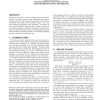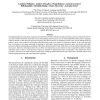3385 search results - page 5 / 677 » Language, Logic, and the Brain |
NN
2008
Springer
13 years 7 months ago
2008
Springer
Brain processes responsible for understanding language are approximated by spreading activation in semantic networks, providing enhanced representations that involve concepts not ...
DMTCS
2007
13 years 7 months ago
2007
The Associative Language Description model (ALD) is a combination of locally testable and constituent structure ideas. It is consistent with current views on brain organization an...
FOSSACS
2004
Springer
14 years 1 months ago
2004
Springer
Soft linear logic ([Lafont02]) is a subsystem of linear logic characterizing the class PTIME. We introduce Soft lambda-calculus as a calculus typable in the intuitionistic and affi...
FOAL
2007
ACM
13 years 11 months ago
2007
ACM
Nonmonotonic logic is a branch of logic that has been developed to model situations with incomplete information. We argue that there is a connection between AOP and nonmonotonic l...
LREC
2010
13 years 9 months ago
2010
Investigating differences in linguistic usage between individuals who have suffered brain injury (hereafter patients) and those who haven't can yield a number of benefits. It...


